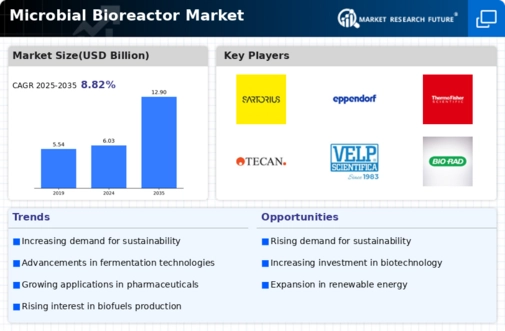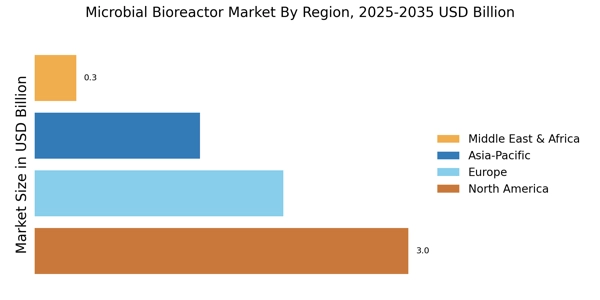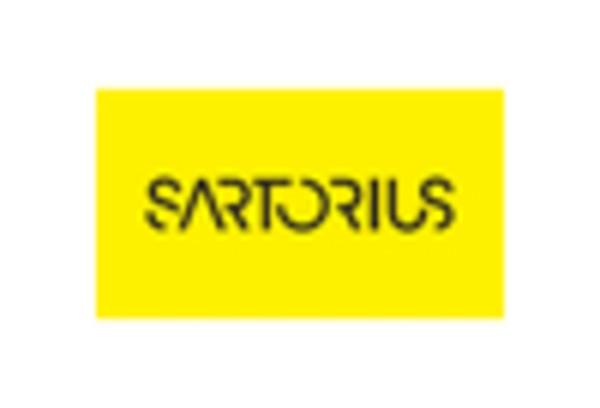Rising Demand for Biopharmaceuticals
The increasing demand for biopharmaceuticals is a primary driver of the Microbial Bioreactor Market. As the healthcare sector continues to evolve, there is a notable shift towards biologics, which are derived from living organisms. This trend is evidenced by the projected growth of the biopharmaceutical market, which is expected to reach approximately USD 500 billion by 2025. Microbial bioreactors play a crucial role in the production of these biologics, offering a controlled environment for the cultivation of microorganisms. The ability to produce complex proteins and antibodies efficiently positions microbial bioreactors as essential tools in biopharmaceutical manufacturing. Consequently, the rising demand for innovative therapies and vaccines is likely to propel the Microbial Bioreactor Market forward.
Expansion of the Food and Beverage Sector
The expansion of the food and beverage sector is a significant driver for the Microbial Bioreactor Market. With the increasing demand for fermented products, such as yogurt, cheese, and probiotics, microbial bioreactors are essential for large-scale production. The Microbial Bioreactor Market is anticipated to grow at a CAGR of over 7% through 2025, indicating a robust demand for microbial fermentation processes. Additionally, the trend towards plant-based diets and alternative protein sources is further propelling the need for microbial bioreactors to produce ingredients like enzymes and flavor compounds. This growth in the food and beverage sector underscores the importance of microbial bioreactors in meeting consumer preferences and enhancing product offerings.
Increasing Focus on Sustainable Practices
The growing emphasis on sustainability is reshaping the Microbial Bioreactor Market. As industries seek to minimize their environmental impact, microbial bioreactors offer a viable solution for producing biofuels, bioplastics, and other sustainable products. The shift towards renewable resources and waste valorization is gaining traction, with microbial processes being recognized for their potential to convert waste into valuable products. Reports indicate that the biofuel market alone is projected to reach USD 200 billion by 2025, highlighting the role of microbial bioreactors in this transition. This focus on sustainability not only aligns with regulatory pressures but also meets consumer demand for eco-friendly products, thus driving the Microbial Bioreactor Market.
Advancements in Bioprocessing Technologies
Technological advancements in bioprocessing are significantly influencing the Microbial Bioreactor Market. Innovations such as continuous bioprocessing and automated control systems enhance the efficiency and scalability of microbial production. These advancements allow for better monitoring and optimization of growth conditions, leading to higher yields and reduced production costs. The integration of artificial intelligence and machine learning in bioprocessing is also emerging, enabling predictive analytics for process optimization. As companies strive to improve productivity and reduce time-to-market for microbial products, the adoption of advanced bioprocessing technologies is expected to accelerate, thereby driving growth in the Microbial Bioreactor Market.
Regulatory Support for Biotechnological Innovations
Regulatory support for biotechnological innovations is fostering growth in the Microbial Bioreactor Market. Governments and regulatory bodies are increasingly recognizing the potential of biotechnology in addressing global challenges, such as food security and healthcare. Initiatives aimed at streamlining the approval processes for biotechnological products are encouraging investment in microbial bioreactor technologies. For instance, the establishment of clear guidelines for the use of genetically modified organisms (GMOs) in bioprocessing is likely to enhance the acceptance and application of microbial bioreactors. This supportive regulatory environment not only boosts research and development efforts but also attracts funding, thereby propelling the Microbial Bioreactor Market.


















Leave a Comment